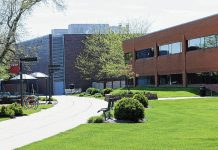A local church that hired a tree service to take down a large hackberry tree that was splitting said the Great Commandment from the Bible was taken into account in its decision.
“This all started with our neighbor who called us to say he was concerned that the tree was dying and would fall on his house,” said Mike Hinckfoot, executive director of ministries for St. Peter’s Lutheran Church, 719 Fifth St., in Columbus.
The 80-foot tall tree was located on the perimeter of the church’s property close to Fourth Street, Hinckfoot said. The church turned to the book of Mark, Chapter 12, verses 30 and 31, which reads: “Jesus said unto him, Thou shalt love the Lord thy God with all thy heart, and with all thy soul, and with all thy mind. This is the first and great commandment. And the second is like unto it, Thou shalt love thy neighbour as thyself.”
Hinckfoot said he personally didn’t want to cut the large tree down. But for the neighbor’s sake, he knew it needed to be checked by a professional. The church called a licensed arborist who examined the hackberry and said it was unstable and needed to be cut down.
The church then scheduled Frank’s Tree and Arbor Services, Columbus, to take down the tree, which was done this week, Hinckfoot said.
On Saturday, a cleanup day for the church, volunteers have been invited to come in and pick up the wood from the tree, which can be used for firewood or for winter heating purposes.
The church spent nearly $2,000 on having the tree evaluated and cutting it down to ensure the neighbor’s home would be safe in the event of a severe storm or wind event that could have toppled it.
Evan Elsbury, whose father Dave Elsbury owns Frank’s Tree Service, said the company found a split down the middle of the tree — which indicated it was unstable — when it was cut down. The tree was at least 50 years old and was about 36-inches in circumference, he said.
One neighbor suggested a pair of nesting hawks lost their home when the tree being cut down, but Elsbury said that was not the case.
The tree-cutting company does not remove a tree that has wildlife in it such as nesting raccoons or nesting birds until animal control is called to assist, Evan Elsbury said. The company even calls beekeepers to assist if they find a beehive in a tree, he said.
“If there is anything actively nesting in a tree, we stop and save the animals, he said.
Although the hackberry is gone, St. Peter’s planted three new trees this past week on the church property, Hinckfoot said.
[sc:pullout-title pullout-title=”About hackberry trees” ][sc:pullout-text-begin]
Arborists describe the hackberry tree as one that can survive in almost any type of soil with tolerance for flooding and drought.
The tree can thrive in a broad span of temperatures and tolerates air pollution. It’s an energy-conserving shade tree that doesn’t require watering.
The tree produces small, dark red, berry-like fruit which is popular with winter birds, especially the cedar waxwing, mockingbird and robin.
In history, hackberry wood was used for barrel hoops, and pioneer cabins often had hackberry wood flooring.
Hackberry trees are considered a shade or an ornamental tree for their large spreading canopy.
Source: The Arbor Day Foundation
[sc:pullout-text-end]




